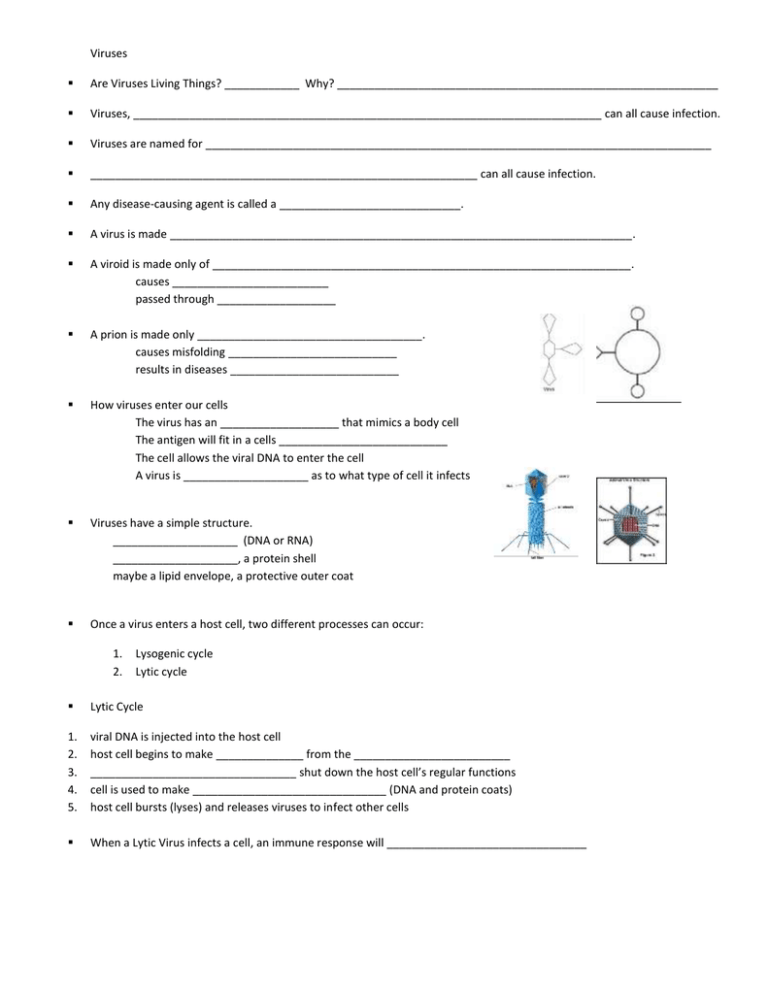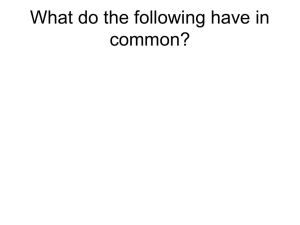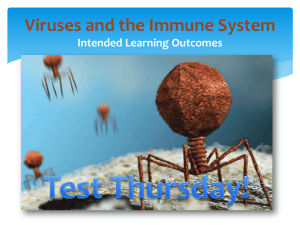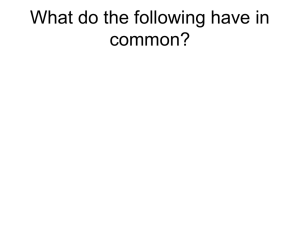Virus Notes
advertisement

Viruses Are Viruses Living Things? ____________ Why? _____________________________________________________________ Viruses, ___________________________________________________________________________ can all cause infection. Viruses are named for _________________________________________________________________________________ ______________________________________________________________ can all cause infection. Any disease-causing agent is called a _____________________________. A virus is made __________________________________________________________________________. A viroid is made only of ___________________________________________________________________. causes _________________________ passed through ___________________ A prion is made only ____________________________________. causes misfolding ___________________________ results in diseases ___________________________ How viruses enter our cells The virus has an ___________________ that mimics a body cell The antigen will fit in a cells ___________________________ The cell allows the viral DNA to enter the cell A virus is ____________________ as to what type of cell it infects Viruses have a simple structure. ____________________ (DNA or RNA) ____________________, a protein shell maybe a lipid envelope, a protective outer coat Once a virus enters a host cell, two different processes can occur: 1. 2. Lysogenic cycle Lytic cycle Lytic Cycle 1. 2. 3. 4. 5. viral DNA is injected into the host cell host cell begins to make ______________ from the _________________________ _________________________________ shut down the host cell’s regular functions cell is used to make _______________________________ (DNA and protein coats) host cell bursts (lyses) and releases viruses to infect other cells When a Lytic Virus infects a cell, an immune response will ________________________________ Lysogenic Cycle 1. 2. 3. 4. viral DNA is injected into the host cell viral DNA is __________________ into the host ___________________ host cell divides with the ____________________ as a part of it eventually the viral DNA can be triggered to separate from the host cell DNA and pick up with the lytic cycle at step 2. A lysogenic infection does no immediate harm Example: Herpes (warts) Viruses cause many ________________________________________________________ There are many examples of viral infections. common cold, influenza RNA viruses do not have built in proofreading, so they ____________________________________________ (like the flu). A special kind of RNA virus, called a ________________________________, can cause DNA to be made from their RNA. Certain cancers, and AIDS are caused by retroviruses. Some viral diseases can be prevented with ________________________________ Vaccines are made from _________________________________________________ A vaccine stimulates the body’s _____________________________________________________________________. Vaccines prepare the immune system for a ____________________________________________________________ Common Cold Causes: _________________ viruses can cause it, including rhinoviruses No evidence for weather causing a cold Symptoms: Runny nose, sore throat, headache, cough Treatment: _____________________________ decongestants & glycerin based cough suppressants NSAIDS (ibuprofen) Transmission: Inhaling drops of mucus full of rhinovirus Touching contaminated surfaces Influenza “the flu” Cause: ______________________________________ Symptoms: Fever, headache, fatigue, body aches, congestion Treatment: CDC currently recommends ___________________________________ for flu due to growing virus resistance. Transmission: Inhaling drops of mucus full of influenza virus Touching contaminated surfaces Status: Vaccines present, BUT it changes yearly (RNA virus) Threat of flu pandemics worldwide Smallpox Cause: __________________________ Symptoms: High fever, body aches, small raised bumps all over body Treatment: ____________________________________________________ Most recover, 30% mortality Transmission: inhaling droplets of affected saliva face-to-face contact with an infected person Status: Vaccine present Can be fatal Eradicated worldwide, last naturally occurring in 1977 Herpes Simplex I Cause: ____________________________________ Symptoms: _____________________________________ Treatment: Topical medication to reduce outbreaks Antiviral medication to reduce number of outbreaks Transmission: Kissing, eating/drinking after one another Status: No vaccine, no cure! Herpes Simplex II Cause: (HSV-2) Herpes Simplex Virus Type 2 Symptoms: Pain, itching, blisters on genitals, anus and thighs Treatment: medication to reduce symptoms and reduce number of outbreaks Transmission: Sexually transmitted, may not be showing signs, oral or vaginal sex Status: No vaccination, no cure! 1 out of 5 adolescents and adults have had HSV-2 in the US! Human Papillomavirus (HPV-warts) Cause: _________________________________________________________ Symptoms: Raised or flat, single or multiple swellings on any genital surface, male or female, can appear cauliflower-like Can cause _______________________________________ in women No visible signs may occur Treatment: Topical creams are available, doctors may freeze or burn them off May remove warts but virus is still present in the body and warts may return Transmission: Very contagious sexual contact with infected partner, may not be showing signs Status: No cure! Tests available for presence in women _______________________________- new vaccine that prevents the 4 highest risk strains of HPV 1. HIV (Human Immunodeficiency Virus) The HIV virus infects cells of the immune system called ___________________________________________ a. Normally Helper T cells activate cells that produce antibodies and cells that destroy cells infected by a pathogen. b. When a Helper T cell is infected by the HIV virus, the immune system cannot fight off infections from pathogens such as bacteria and other viruses. c. HIV can cause _____________________________________________________ when enough Helper T cells are infected so the immune system does not work properly. d. People with HIV infections can get sick easily because their immune system does not work properly. People with AIDS do not die from the HIV virus, but from _____________________________________________________ Cause: Human Immunodeficiency Virus Symptoms: Fever, headache, tiredness, enlarged lymph nodes AIDS (Acquired Immunodeficiency Syndrome) weight loss, fatigue, memory loss Destroys Helper T cells (part of immune system) body cannot fight off illnesses caused by bacteria, other viruses, fungi, or parasites. Ultimately leads to death Treatment: Reverse Transcriptase (RT) inhibitors & Protease Inhibitors- stops the virus from making copies of itself Transmission: sexually (orally, vaginally) Blood (needles, or through mucus membranes) Breast milk mother to child NOT from kissing, touching, insects bites Status: No vaccine, several medicines to prevent spread in body Worldwide: In 2004, 40 million people living with HIV/AIDS, 5 million newly infected, and 3.1 million deaths Ebola Hemorrhagic Fever Cause: 1 of 4 Ebola viruses Symptoms: Fever, headache, muscle/joint pain, red eyes, skin rash Diarrhea, vomiting, rash, internal and external bleeding Treatment: No standard treatment Some patients recover but majority die, usually because the lack of immune response Transmission: Contaminated body fluids: Blood, mucus, semen, syringes Air transmission in monkey Ebola-Reston virus only Status: Only identified in 1976 with few devastating outbreaks RNA virus







